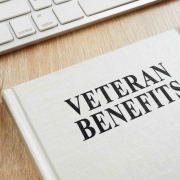Now More Than Ever Veterans Benefits Planning is Essential
The COVID-19 virus is not going away as many had hoped. And studies have shown it is deadlier for those over the age of 65. Individuals living in senior living communities, such as independent living, assisted living, memory care, and nursing homes have the highest risk of becoming infected and possibly dying from the virus or secondary illness, such as pneumonia, after being weakened from the virus. For many families, providing long term care for a loved one in the home has become an even bigger priority than normal. In-home care can be costly, which makes the Aid and Attendance Benefit provided by the Department of Veteran’s Affairs of critical importance to help pay for such care.
Veteran Aid and Attendance Benefit
The Aid and Attendance Benefit, technically called the Improved Pension Benefit, is a cash benefit paid to wartime veterans that are over the age of 65 and require another person to assist them with activities of daily living, such as bathing, dressing, feeding, and assistance with incontinence, or requires a protective environment due to mental decline. The Aid and Attendance Benefit is also available to similarly disabled spouses of deceased wartime veterans that are over the age of 65. It is this need for assistance with care or a protective environment that has the family looking into long term care facilities for their loved one.
The Aid and Attendance eligibility rules also require the person receiving the benefit of having limited income. Simply put, all income of the applicant and the applicant’s spouse must be offset by the medical expenses of the applicant and the applicant’s spouse. Any income not offset by medical expenses reduces the amount of the benefit. Under the Aid and Attendance rules, when the wartime veteran or surviving spouse requires assistance with activities of daily living or a protective environment, paying an in-home caregiver to provide that care is a medical expense. It does not matter whether the caregiver is a child or hired through an agency.
Current Veteran Benefits
For 2020, the maximum benefit paid to a married wartime veteran is $2,266 per month. The maximum benefit paid to a single wartime veteran is $1,911. The maximum benefit paid to a surviving spouse of a wartime veteran is $1,228. Working carefully through the math, if a married wartime veteran needs long term care and has a household income of $4,000 per month, he or she will need to spend $4,000 per month on medical expenses to receive $2,266 per month. That veteran likely already has medical expenses in the form of two Medicare and two Medicare supplement premiums, as well as possibly two Medicare prescription supplements. The remaining income needs to be spent on additional medical expenses, specifically an in-home caregiver.
The family must now decide the best way to navigate paying the in-home caregiver. If the couple has children, perhaps the remainder of the household income can be paid to a child, or split among the children, as payment for caregiver services. In many cases, using a child or children as a caregiver allows for flexibility in the amount a caregiver is paid. The income calculation can be manipulated to net out at exactly zero, instead of going into the negative. This allows the veteran to use the $2,266 per month benefit to pay for the couple’s non-medical living expenses.
Other Veteran Benefits for Caregiving
The other option is to hire a caregiver from an agency. This option is more expensive than using a child as a caregiver, but it comes with the added benefit of ensuring taxes are withheld and workers’ compensation insurance is provided in case of an accident. If the family wants the income calculation to net out at exactly zero, the veteran typically will not get as many hours of service from the caregiver hired through an agency compared to hiring a child since an agency typically charges a higher per hour rate. This would work well for a veteran that does not need a lot of care, or that has a wife and/or children that can cover the additional hours of care for free. Otherwise, the agency will need to be paid to provide the additional hours of service, which means the $2,266 benefit paid by the Department of Veterans Affairs will also be used to pay for the care and the couple will have to use assets to pay for the couple’s non-medical living expenses.
The Aid and Attendance Benefit also has an asset limit the applicant must meet, along with a penalty for giving assets away and a 3-year period to look back at the applicant’s assets to see if any gifts were made. These rules should not dissuade a wartime veteran or surviving spouse from seeking this benefit. The need for long-term care will only increase. The cost of care will only increase. And now the COVID-19 virus makes it critical that everything possible is done to protect this vulnerable community.
If you have questions or would like to discuss whether you or a loved one may qualify for Veterans Benefits, please don’t hesitate to reach out. Please contact our office by calling us at (318) 255-1760 and schedule an appointment to discuss how we can help you with your VA planning needs.


